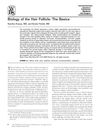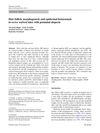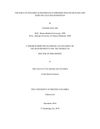TLDR The study found that a one-step antibody method is better than the LSAB method for accurately studying hair follicle structures without false positives.
This study demonstrated that the 1-step, peroxidase-labeled conjugated secondary antibody method was more effective than the 2-step LSAB method for immunohistochemistry (IHC) of pilosebaceous units. The LSAB method, despite its signal amplification advantage, led to poor differential immunoreactivity (IR) separation and false-positive staining in sebaceous glands (SGs). In contrast, the 1-step method provided more distinct IR patterns without false positives, making it preferable for accurately characterizing and localizing hair follicle (HF) substructures, particularly the bulge regions. This finding suggested that the 1-step method should be the IHC method of choice for studying pilosebaceous units.
142 citations
,
January 2010 in “Journal of dermatological science” Hair follicles are promising targets for delivering drugs effectively.
 224 citations
,
March 2006 in “Seminars in Cutaneous Medicine and Surgery”
224 citations
,
March 2006 in “Seminars in Cutaneous Medicine and Surgery” The document concludes that understanding hair follicle biology can lead to better hair loss treatments.
 27 citations
,
January 2006 in “Colloids and Surfaces B: Biointerfaces”
27 citations
,
January 2006 in “Colloids and Surfaces B: Biointerfaces” Researchers found that bulge cells from human hair can grow quickly in culture and have properties of hair follicle stem cells, which could be useful for skin treatments.
25 citations
,
October 2007 in “Developmental biology” Clim proteins are essential for maintaining healthy corneas and hair follicles.
 7 citations
,
November 2014 in “Histochemistry and Cell Biology”
7 citations
,
November 2014 in “Histochemistry and Cell Biology” The we/we wal/wal mice have defects in hair growth and skin layer formation, causing hair loss, useful for understanding alopecia.

Integrin alphavbeta6 is important for wound healing and hair growth, and blocking it may improve these processes.
 March 2015 in “Zagazig University Medical Journal”
March 2015 in “Zagazig University Medical Journal” Damage to hair follicle stem cells may cause permanent hair loss and scarring in PCA.
 21 citations
,
July 2006 in “Veterinary dermatology”
21 citations
,
July 2006 in “Veterinary dermatology” CD34 marks potential stem cells in dog hair follicles.





